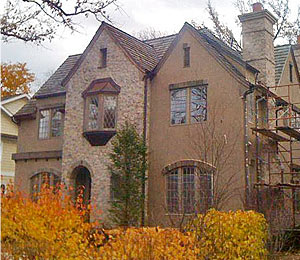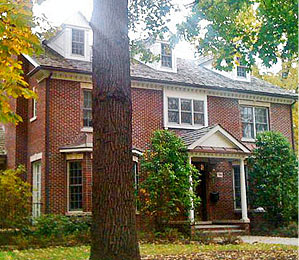
List Price: $1,336,500
Sale Price: $1,300,000

List Price: $1,434,265
Sale Price: $1,260,000
The Properties: Both of these Winnetka houses sold in October as foreclosures. In each case, the buyers got the house for at least $1 million less than its presumed value—and a closer look at those sales reveals the different ways foreclosures can impact affluent and lower-income communities.
The stucco and stone house was sold on October 30th for $1.3 million; its last owners had paid $2.57 million for the place in 2006, when the house was new. The red brick house was sold on October 9th for $1.26 million; in 2007, its last owners had taken out a $2.8-million mortgage on the place. They had bought the property in 2002 for $925,000. (All mortgage and sales information is from the Cook County Recorder of Deeds. I could not track down the former owners of either home for comment, and the names of the most recent buyers have not yet appeared in public records.)
The lending banks took back both houses in March 2009. Both houses were sold again within seven months; according to the listing sheet, there were multiple competing offers on the stucco house. Those relatively quick sales are only more evidence that the real-estate crisis is impacting affluent neighborhoods in a very different way than it does poor neighborhoods. “More affluent areas, even though they are experiencing increasing levels of foreclosure, are still more stable and more likely to recover faster than lower-income communities that have had a major accumulation of these properties,” says Geoff Smith, vice president of the Woodstock Institute. “There are folks [in affluent neighborhoods] who have the money to be opportunistic and take advantage of the current market.”
Last week the Woodstock Institute, a Chicago-based nonprofit that promotes economic development in lower-income and minority communities, reported that foreclosures have slowed in low-income parts of the city and south suburbs; at the same time, they have spiked in the more affluent collar counties. Earlier research from the institute indicated that foreclosed properties take at least 25 percent longer to be resold in predominantly African American communities than they do in mostly white communities.
Price Points: Many homes in the first waves of foreclosures had been secured by subprime mortgages or exotic loans that allowed a buyer to put down a minimal down payment. That doesn’t seem to apply to either of these houses. Cook County records show that the $2.57 million purchase of the stucco house was accompanied by a $1.5 million mortgage, which suggests the buyers had put down $1.07 million. At the red brick house, the buyers put down $231,250, or 25 percent of their original purchase price.
Listing Agent: (stucco house) Patti Furman at Coldwell Banker, 847-729-7261; (red brick house) N/A


